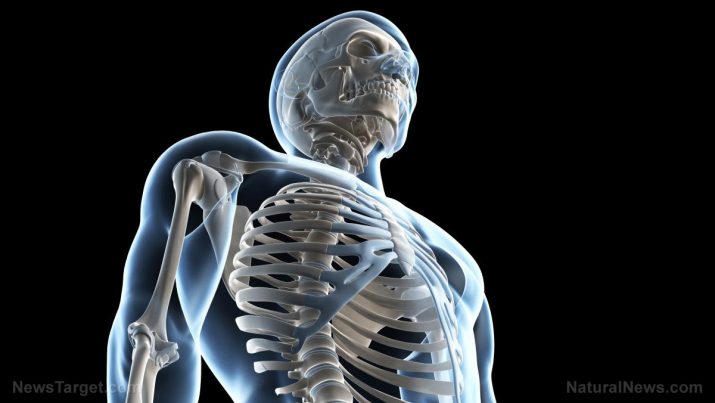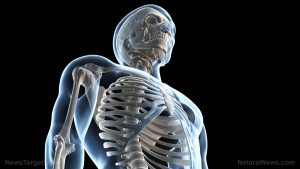
Chondrosarcoma – causes, side effects and treatments at NaturalPedia.com
Wednesday, February 28, 2018 by Zoey Sky
http://www.naturalpedia.com/chondrosarcoma-causes-side-effects-and-treatments-at-naturalpedia-com.html

Chondrosarcoma is a type of cancer that forms in bone cartilage. The disease often begins in the pelvis (the area between the hip bones), the shoulder, the ribs, or at the ends of the long bones of the arms and legs.
Extraskeletal chondrosarcoma, a rare type of chondrosarcoma, does not form in bone cartilage. It develops in the soft tissues found in the upper part of the arms and legs.
An individual may develop chondrosarcoma at any age, but the disease is more common in people older than 40 years. Chondrosarcoma rarely occurs in children, and it is a type of bone cancer.

Known side effects of chondrosarcoma
Some of the known symptoms of chondrosarcoma include:
- Changes in urination – Linked to pelvic tumors.
- Difficulty moving the affected limb
- The enlargement of an existing growth
- Limping
- Pain in the affected area – This may worsen at night or during exercise, heavy lifting, or physical activity.
- The presence of a lump or mass
- Swelling in the painful area
Do take note that the presence of these symptoms do not necessarily mean that you have cancer. However, you must consult a healthcare professional immediately if you experience any or all of them.
Body systems harmed by chondrosarcoma
Once chondrosarcoma develops, it will either grow rapidly or slowly. Chondrosarcoma may metastasize or invade nearby tissues and spread to cartilage and bones in other parts of the body. It can also spread to other tissues and organs, like the lungs.
If cancer spreads to the bones or cartilage from cancer in another part of the body, like the breast, it is not called chondrosarcoma. This is instead called metastatic breast cancer.
Food items or nutrients that may prevent chondrosarcoma
Before and during bone cancer treatment, patients must eat a “high-protein, high-calorie diet” so their body will have enough energy during treatment. Remember that even if you lose your appetite, you have to eat and maintain your weight.
Before your treatment, following a healthy diet will help you keep up your strength, rebuild, and protect body tissues, and boost your immune system against infection. Eat:
- High-protein foods – Beans, eggs, fish, legumes, meats, milk products, poultry, and nuts.
- High-calorie foods – Butter, gravies, margarine, milk products, salad dressings, sauces, and sweets.
Follow these tips to maintain proper nutrition during treatment:
- Surgery – To get the extra calories and protein that your body needs to heal and recuperate, eat small and frequent meals. Healthy snacks and plenty of fluids will help prevent dehydration.
- Radiation therapy – Always try to eat something at least one hour before each treatment. Small frequent meals will be better for you, especially if you are having a hard time eating.
- Chemotherapy – Nausea caused by chemotherapy drugs can make you lose your appetite, so try to eat when your appetite is good. Protein will give you an energy boost, which will help against the fatigue that usually comes with chemotherapy.
You can return to a more traditional diet after treatment:
- Avoid fatty foods – Choose baked or broiled foods over fried foods.
- At least five to seven servings of fruits and vegetables daily – Include colorful vegetables to ensure that you consume different nutrients.
- High-fiber foods – Such as whole grain bread and cereals.
- Low-fat milk and dairy products
Treatments, management plans for chondrosarcoma
Treatment for chondrosarcoma is often determined by the following:
- The expectation for the course of the disease.
- Patient age, overall health, and medical history.
- The patient’s opinion or preference.
- The type, stage/extent, and location of the cancer.
- Tolerance to specific medicines, procedures, and therapies.
Chondrosarcoma treatment will try to remove the mass and lower the chances of a recurrence. Follow-up care with a healthcare professional may be required.
Treatment plans for the disease may include the following:
- Chemotherapy – While not the primary treatment, chemo may be required if cancer has spread to other body parts.
- Surgery – Performed to remove the tumor. If the tumor is located on an arm or leg, the surgeon will try to save the limb. However, amputation might be needed for some cases.
- Physical therapy – This treatment can help the patient regain strength and mobility in the affected area post-surgery.
- Radiation therapy – May be given at high doses.
Where to learn more
- Handicapped people concerned that legalization of physician-assisted suicide would eventually target them for “voluntary euthanasia”
- Large Study Shows Agent Orange Exposure Doubles Prostate Cancer Risk
- CancerCauses.news
- Health.news
- NaturalCures.news
Summary
Chondrosarcoma is a type of cancer that forms in bone cartilage. The disease often begins in the pelvis (the area between the hip bones), the shoulder, the ribs, or at the ends of the long bones of the arms and legs.
Some of the known symptoms of chondrosarcoma include changes in urination, difficulty moving the affected limb, and the enlargement of an existing growth.
Once chondrosarcoma develops, it will either grow rapidly or slowly. Chondrosarcoma may metastasize or invade nearby tissues and spread to cartilage and bones in other parts of the body. It can also spread to other tissues and organs, like the lungs.
Before and during bone cancer treatment, patients must eat a “high-protein, high-calorie diet” so their body will have enough energy during treatment.
Treatment plans for the disease may include chemotherapy, surgery, physical therapy, and radiation therapy.
Sources include
Tagged Under: Tags: chondrosarcoma





